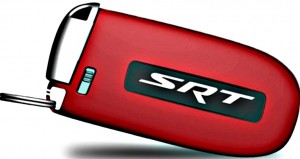
The red key fob unleashes all 707 horsepower in the Dodge Challenger Hellcat. The black key limits a driver to "just" 500-hp.
Officially, it isn’t a recall, just a technical service bulletin, but whatever General Motors is calling the announcement, dealers have been advised to replace the keys on 2014 and 2015 Chevrolet Silverado and GMC Sierra models, as well as several other large pickups and SUVs.
Some owners have complained that when they shift gears they can knock the ignition switch out of position – bringing to mind this year’s earlier recall of GM vehicles equipped with defective ignition switches now linked to 38 deaths and 100s of injuries.
While that has put the spotlight on GM, the maker is just one of several to order recalls in recent years due to key and ignition switch problems – which is adding more momentum to a broad industry shift away from conventional ignition switches to push-button starters.
(GM deals with new ignition switch, airbag problems. Click here for the latest.)
Virtually every Nissan model now uses a version of the Japanese maker’s Intelligent Key system, from the entry-level Versa up to the top-line Infiniti QX80 SUV. And more and more makers, domestic and import, are following Nissan’s lead.
“Eventually, the key will go away,” forecasts Dave Sullivan, a senior analyst with consulting firm AutoPacific, Inc. He expects that only a handful of models – mostly base-level trucks – will continue to use conventional keyed ignition systems.
That view is echoed by automotive research site Edmunds.com, which notes that some form of push-button switch was available, either as a standard feature or an option, on 72% of the cars and trucks sold in the U.S. during the 2014 model-year.
Ford has abandoned keys on all models but for its two new vans, the full-size Transit and midsize Transit Connect.
(Lexus launching new, near-autonomous safety technology. Click Here to learn more.)
Meanwhile, General Motors CEO Mary Barra told members of the House Energy and Commerce subcommittee that, “The push-button start is something we’re evaluating putting across the portfolio,” during hearings on the maker’s ignition switch recall last spring. Keyless systems are now being used on nine GM models.
As the various GM recalls have underscored, keyed ignition systems can inadvertently be jostled out of position, and when that happens, a vehicle can shut off and go out of control. But safety is just one of the reasons why manufactures are opting for alternatives.
“Real estate is at a premium” inside a vehicle, explains Sullivan, noting that automotive designers and engineers are trying to clear space for all the various technologies they need to squeeze into the passenger compartment, such as large touchscreen displays – never mind the requisite cupholders and storage bins.
The new 2015 Nissan Murano has just 10 buttons, a third as many as the model it replaces. Chrysler’s big Ram 1500 has opted for a rotary transmission shifter rather than the traditional lever. And both offer keyless ignition switches which are easier for designers and engineers to move to an open space on the instrument panel.
There are a variety of different types of keyless ignitions. Some simply eliminate the key but still require a driver to turn a knob on the side of the steering column, something used in several Mazda models. Most others have opted for push-button starters which, the argument goes, has a more sporty, high-tech feel.
Keyless ignition systems aren’t a panacea. When it was struggling to deal with its unintended acceleration problems, five years ago, Toyota discovered that some motorists were unable to stop runaway vehicles equipped with push-button starters. It eventually advised owners to, “firmly and steadily push the button for at least three seconds to turn off the engine. Do NOT tap the engine start/stop button.”
Meanwhile, there is growing concern that hackers might be able to crack the code and start stealing cars equipped with keyless entry and ignition systems. But while that possibility has been demonstrated in the lab there have been no reports of that happening on the street – yet.
Citing 100s of complaints about keyless systems, the National Highway Traffic Safety Administration has been studying the technology and could issue national standards next year.
That said, the agency is not expected to limit the use of keyless technology – which has also become one of the hot trends in home automation this year. Some keyless door locks, from companies like Schlage, require a user to enter a four-digit code, much like accessing a bank’s ATM. Others, from such vendors as Kevo and Okidokeys, can be operated using a smartphone or a hotel-style key card.
And analyst Sullivan expects to see something similar happen with the automobile, perhaps even using a fingerprint detector, much like the system on the latest iPhones.
Whatever form they take, keyless systems offer some unique opportunities compared to standard keyed ignition switches. It makes it easier to track who is using a vehicle, for one thing.
Ford’s MyKey system allows a parent to provide a teen driver with a special key fob that can restrict their maximum speed, and even limit how loud the radio can be played. Dodge, meanwhile, provides two different colored smart keys for its Charger and Challenger Hellcat models. The red key unleashes the muscle cars’ full 707-horsepower, the black limiting a driver to “only” 500-hp.
(Click Here for a first look at Volvo’s new “twin engine” XC90 T8 plug-in hybrid.)


Unfortunately electronic keys are not the solution to many issues. Hackers have already compromised the electronic key technology so the situation is dire, IMO. In addition the various power level keys are going to result in liability lawsuits as young people find a means to circumvent the limitations of the lower powered key.
I like my old keys. When they go through the washing machine, the come out clean – and still work fine. Ever think about the cost of digital key replacement? I did, when I replaced the failing key in my Mazda, for $900.
I had a Renault Megane. They used a Card for Ignition, Shut down and Door Lock. One day I arrived to a parking place in a supermarket. I shutted down the Engine in Neutral position and I did not apply the manual brake. I locked the car and went into the store. When I came back, my car was not in the place where I parked. It was against another car in reverse. It rolled down. Fortunatelly was not against other person. I had to pay the repair of the other car. I reported the issue to Renault in Mexico but I did not receive any support.
Yes, electronic is nice, but safety is first. My car could have injured a person. Systems must be fool proof.
Thanks.
The on-off button must be positioned in an accessible, easy to find position. Many of the cars I work on almost hide the switch. Ease of use for anyone should be a first design.
I like my keys!! There is no reason engineers can not make a key system that makes it impossible to know out of the ignition. Keys are easy to replace and harder to damage.